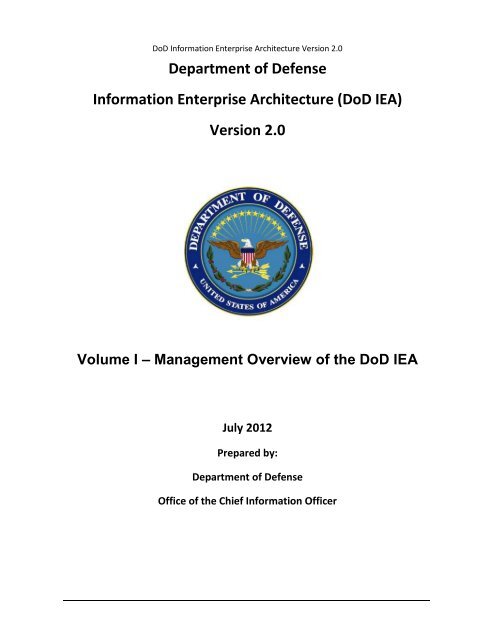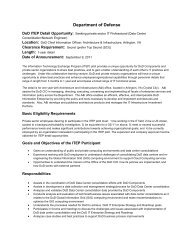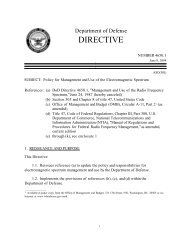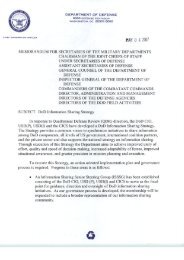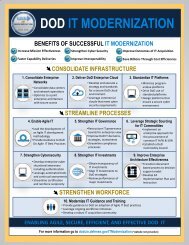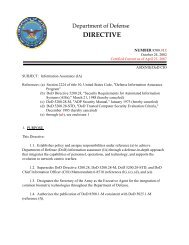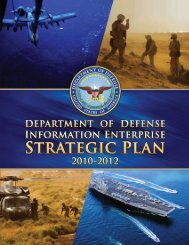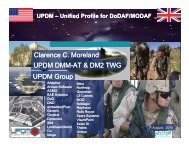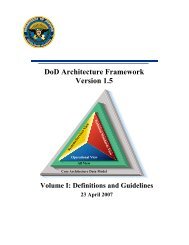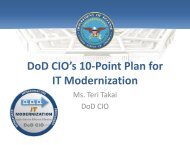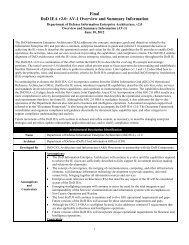DoD IEA v2.0 - Chief Information Officer
DoD IEA v2.0 - Chief Information Officer
DoD IEA v2.0 - Chief Information Officer
You also want an ePaper? Increase the reach of your titles
YUMPU automatically turns print PDFs into web optimized ePapers that Google loves.
<strong>DoD</strong> <strong>Information</strong> Enterprise Architecture Version 2.0Department of Defense<strong>Information</strong> Enterprise Architecture (<strong>DoD</strong> <strong>IEA</strong>)Version 2.0Volume I – Management Overview of the <strong>DoD</strong> <strong>IEA</strong>July 2012Prepared by:Department of DefenseOffice of the <strong>Chief</strong> <strong>Information</strong> <strong>Officer</strong>
<strong>DoD</strong> <strong>Information</strong> Enterprise Architecture Version 2.0EXECUTIVE SUMMARYIn the face of numerous, varied, and complex <strong>Information</strong> sharing challenges facing theDepartment, the <strong>DoD</strong> CIO has set a vision to deliver an <strong>Information</strong> Enterprise (IE) that enables<strong>DoD</strong> and partners to securely access information and services they need at the time, place and onapproved devices of their choosing. To achieve this vision the <strong>DoD</strong> CIO is leading a newunifying initiative called the Joint <strong>Information</strong> Environment (JIE) focused on five major focusareas which are driven by and aligned to Joint requirements. The <strong>DoD</strong> <strong>IEA</strong> <strong>v2.0</strong> is theauthoritative capstone architecture that describes priority areas, principles and rules, andactivities that guide the evolution of the <strong>DoD</strong> IE to realize the JIE vision.The five major focus areas of the JIE will be delivered incrementally with increasingoptimization of information, network, hardware, applications and governance. The JIE isfocused on delivery of IT infrastructure that compliments warfighting and mission capabilities.Four of the initial focus areas that deliver capabilities are Data Center Consolidation, NetworkNormalization, Identity and Access Management (IdAM), Enterprise Services, all within a singleSecurity Architecture. Each of these focus areas will have a reference architecture that leveragesthe content from the <strong>DoD</strong> <strong>IEA</strong> <strong>v2.0</strong>.The value of the <strong>DoD</strong> <strong>IEA</strong> is that it provides a clear, concise description of what the <strong>DoD</strong> IEmust be and how its elements should work together to accomplish such a transformation anddeliver effective and efficient information and service sharing. <strong>Information</strong> is viewed as astrategic asset throughout the Department and includes everything along the continuum fromdata to knowledge. The <strong>DoD</strong> <strong>IEA</strong> enables proper planning for shaping the <strong>DoD</strong> IT landscape,managing the acquisition of required resources, and effectively operating the resulting ITenvironment. The <strong>DoD</strong> <strong>IEA</strong> describes a future vision for the JIE based on merging missionoperational needs with the concepts previously embedded in separate net-centric strategies. It issubdivided into a manageable set of required capabilities which are discrete actions the <strong>DoD</strong> IEmust either perform or provide. Each of these capabilities is described in terms of activities,services, and rules necessary to ensure the capability is achieved. The <strong>DoD</strong> <strong>IEA</strong> outlines howcapabilities are delivered by providing descriptions of services the <strong>DoD</strong> IE must have to operateat optimum effectiveness. These services represent a collection of required information acrossthe spectrum of Doctrine, Organization, Training, Material, Leadership and education, Personnel,Facilities, and Policy (DOTMLPF-P).The capability descriptions allow the development of a transition plan to evolve from the current<strong>DoD</strong> IE to the future vision of JIE. A common view and understanding of the <strong>DoD</strong> IE enablesstakeholders to determine their path for IT transformation and develop and direct a unifiedapproach to achieve that transformation across the Department by providing the basis foracquisition decisions, portfolio assembly and implementation, and planning, programming, andbudget execution.i
<strong>DoD</strong> <strong>Information</strong> Enterprise Architecture Version 2.0Major stakeholders of the <strong>DoD</strong> <strong>IEA</strong> are: architects, investment decision-makers, and programmanagers. Architects use the <strong>DoD</strong> <strong>IEA</strong>’s content and structured view of what the <strong>DoD</strong> IE mustbe and how it must operate to develop Reference Architectures (RAs). These RAs provide thenecessary level of technical direction and standards to direct development of standardized,interoperable or consistent solutions across the Department. They are incorporated into the <strong>DoD</strong><strong>IEA</strong> as extensions of the requirements. Architects also use the content of the DOD <strong>IEA</strong> andapproved RAs to develop Mission Area, Component, and solution architectures able to drive JIEconformantsolutions. Investment decision-makers use the descriptions of required <strong>DoD</strong> IEcapabilities as a baseline to determine where existing and projected capabilities will not achievethe <strong>DoD</strong> IE vision. They then determine how to spend available funds to fill identified gaps.Program managers use the <strong>DoD</strong> IE capability descriptions to design programs and then measuretheir progress towards achieving desired capabilities as described in their <strong>Information</strong> SupportPlans (ISP). They also use the rules associated with capability descriptions to guide and testprogram abilities.The <strong>DoD</strong> <strong>IEA</strong> is the authoritative source for <strong>DoD</strong> CIO-designated architecture governancebodies to determine compliance with the IE vision in achieving mission effectiveness, cybersecurity, and efficiency goals. Strategic planners and policy writers must incorporate <strong>DoD</strong> <strong>IEA</strong>content during development of their documents. Compliance guidance is provided in varioussections of the <strong>DoD</strong> <strong>IEA</strong> as described below.For ease of use, <strong>DoD</strong> <strong>IEA</strong> <strong>v2.0</strong> has been divided into the following:• Volume I – a managerial and key decision-maker overview of the <strong>DoD</strong> <strong>IEA</strong> <strong>v2.0</strong>• Volume II – an architect compendium on the <strong>DoD</strong> <strong>IEA</strong> <strong>v2.0</strong> architectural description and,appendices on use of (Appendix D) and compliance with the <strong>DoD</strong> <strong>IEA</strong> <strong>v2.0</strong> (AppendixE) and compliance with the <strong>DoD</strong> Enterprise Architecture (DOD EA) (Appendix G)• <strong>DoD</strong> <strong>IEA</strong> <strong>Information</strong> Reference Resource (I2R2) Tool – search and understand therelationships of policy, guidance and other authoritative documents with DOD <strong>IEA</strong> <strong>v2.0</strong>capabilities/servicesIn today’s information environment the <strong>DoD</strong> <strong>IEA</strong> rules apply within the persistently-connectedInternet Protocol (IP) boundaries of the Global <strong>Information</strong> Grid (GIG). Outside of theseboundaries, the principles still should be considered, but the rules of the <strong>DoD</strong> <strong>IEA</strong> must yield tothe state of technology, and the needs and imperatives of the Department’s missions.ii
<strong>DoD</strong> <strong>Information</strong> Enterprise Architecture Version 2.0TABLE OF CONTENTSINTRODUCTION FOR THE DOD <strong>IEA</strong> V2.0 ....................................................................................... 11 OVERVIEW OF THE DOD <strong>IEA</strong> V2.0 ................................................................................................ 11.1 Purpose ............................................................................................................................................................ 21.2 Goals ................................................................................................................................................................ 21.3 Scope ............................................................................................................................................................... 32 DOD <strong>IEA</strong> DOCUMENT ORGANIZATION ........................................................................................ 7VOLUME I – MANAGEMENT OVERVIEW OF THE DOD <strong>IEA</strong> ....................................................... 91 INTRODUCTION .............................................................................................................................. 92 VOLUME I ORGANIZATION ......................................................................................................... 93 SUMMARY OF CONTENT IN THE DOD <strong>IEA</strong> V2.0 ........................................................................ 93.1 Vision of the Future IE ...................................................................................................................................... 93.2 IE Capabilities ................................................................................................................................................. 123.3 Operational Activities, Services, and Rules ..................................................................................................... 133.3.1 Operational Activities in the <strong>DoD</strong> <strong>IEA</strong> <strong>v2.0</strong> ..................................................................................................... 133.3.2 Services in the <strong>DoD</strong> <strong>IEA</strong> <strong>v2.0</strong> ........................................................................................................................... 143.3.3 Rules in the <strong>DoD</strong> <strong>IEA</strong> <strong>v2.0</strong> ............................................................................................................................... 143.3.4 Application of and Compliance with the <strong>DoD</strong> <strong>IEA</strong> <strong>v2.0</strong> .................................................................................. 144 STAKEHOLDERS USE OF THE DOD <strong>IEA</strong> ..................................................................................... 144.1 <strong>DoD</strong> <strong>IEA</strong> Support to Architecture Development ....................................................................................... 154.2 <strong>DoD</strong> <strong>IEA</strong> Support to IT Investment and Planning Management ............................................................... 154.2.1 <strong>DoD</strong> <strong>IEA</strong> Support to Investment Planning .................................................................................................. 164.2.2 <strong>DoD</strong> <strong>IEA</strong> Support to IE Strategic Planning................................................................................................... 164.2.3 <strong>DoD</strong> <strong>IEA</strong> Support to IE Initiative/Program Planning and Oversight ............................................................ 164.2.4 <strong>DoD</strong> <strong>IEA</strong> Support to IE Policy Formation .................................................................................................... 174.3 <strong>DoD</strong> <strong>IEA</strong> Support to IT Program Management ......................................................................................... 17iii
<strong>DoD</strong> <strong>Information</strong> Enterprise Architecture Version 2.05. TOOLS FOR USING THE DOD <strong>IEA</strong>............................................................................................... 17iv
<strong>DoD</strong> <strong>Information</strong> Enterprise Architecture Version 2.0Introduction for the <strong>DoD</strong> <strong>IEA</strong> <strong>v2.0</strong>1 Overview of the <strong>DoD</strong> <strong>IEA</strong> <strong>v2.0</strong>The <strong>DoD</strong> <strong>Information</strong> Enterprise Architecture (<strong>DoD</strong> <strong>IEA</strong>) is the authoritative capstonearchitecture that sets the operational context and vision of the <strong>Information</strong> Enterprise (IE). Itaddresses the concepts, strategies, goals and objectives related to the IE and provides a common,enterprise foundation to guide and inform IT planning, investment, acquisition and operationaldecisions in achieving the IE vision. It describes the IE capabilities that enable <strong>DoD</strong> operationsby establishing the activities, rules and services involved in providing the IE capabilities. Inorder to oversee the <strong>DoD</strong> transition to the IE vision, the <strong>DoD</strong> <strong>IEA</strong> <strong>v2.0</strong> has provided enhancedcompliance criteria. The <strong>DoD</strong> <strong>IEA</strong> enables alignment of <strong>DoD</strong> architectures with the IE vision,drives enterprise solutions, promotes consistency throughout the <strong>DoD</strong> IE and complements theIT Enterprise Strategy and Roadmap (ITESR).The <strong>DoD</strong> <strong>IEA</strong> <strong>v2.0</strong> is a continuation of the effort within the <strong>DoD</strong> CIO to describe the evolvingIE concepts and strategic positions. Previous versions of the <strong>DoD</strong> <strong>IEA</strong> were priority area baseddescriptions of the IE. The initial version (v1.0) identified five priority areas to focus near-termdecision making and established a baseline framework of principles and rules to guideinvestments in these areas. Later updates (v1.1 and v1.2) described how to apply the principles,rules, and associated activities; criteria for <strong>DoD</strong> <strong>IEA</strong> compliance; and provided <strong>DoD</strong> EnterpriseArchitecture (EA) compliance requirements. The <strong>DoD</strong> <strong>IEA</strong> <strong>v2.0</strong> describes the vision for thefuture IE and the initial set of capabilities it must provide to enable <strong>DoD</strong> Mission Area andComponent operations. The <strong>DoD</strong> <strong>IEA</strong> <strong>v2.0</strong> focuses primarily on warfighter operationalrequirements that include a smaller set of operational requirements that are common across allMission Areas and Components. It was also developed using information from existing sourceswith differing purposes, scopes, and perspectives. The continued evolution of the <strong>DoD</strong> <strong>IEA</strong> willenhance the capabilities to address unique mission area and component requirements; refine andbetter focus the activities, rules, functions, and services used to achieve the IE capabilities; andincrease the level of detail and analysis to further support IT investment decision making andsolution development for the IE.To accommodate operational needs, the <strong>DoD</strong> <strong>IEA</strong> <strong>v2.0</strong> has evolved to a capability baseddescription of the <strong>DoD</strong> <strong>IEA</strong>. It incorporates content from the Global <strong>Information</strong> Grid (GIG) 2.0Operational Reference Architecture (ORA); clarifies the IE vision; introduces required IEcapabilities described through activities, rules, services, and standards; and continues toinstitutionalize this content. The capabilities described in the <strong>DoD</strong> <strong>IEA</strong> <strong>v2.0</strong> align closely withthe Net-Centric Joint Capability Area (JCA). Incorporation of the GIG 2.0 ORA results in morecomprehensive activity decompositions and an operational context that describes the operationalconcepts, characteristics, and requirements that drive the future IE. The GIG 2.0 ORA alsoaddresses the day-to-day operations of the Department that are relevant to business andintelligence operations.Enterprise-wide Reference Architectures (RAs) play a key role in extending the <strong>DoD</strong> <strong>IEA</strong> andproviding more detailed information to guide and constrain solutions and implementations for a1
<strong>DoD</strong> <strong>Information</strong> Enterprise Architecture Version 2.0specific focus area. These RAs, along with general <strong>DoD</strong> <strong>IEA</strong> information, provide the basis forcompliance with the <strong>DoD</strong> <strong>IEA</strong>. A content navigation support tool, referred to as the <strong>IEA</strong><strong>Information</strong> Reference Resource (I2R2) is also being developed to accompany the <strong>DoD</strong> <strong>IEA</strong><strong>v2.0</strong>. The I2R2 consolidates and organizes compliance and guidance information by documenttype, capability type, and other categories to help understand compliance and analysis.Future increments of the <strong>DoD</strong> <strong>IEA</strong> will continue to enhance and refine content, as necessary, todescribe changing enterprise strategies and priorities; update relationships, application, and use;and clarify compliance criteria.1.1 PurposeThe purpose of the <strong>DoD</strong> <strong>IEA</strong> <strong>v2.0</strong> is to provide a strategic level architecture to stakeholders. The<strong>DoD</strong> <strong>IEA</strong> will be extended with detail by developing reference architectures. The content of the<strong>IEA</strong> and the RAs will be provided in formats supporting different stakeholder needs, donethrough a set of tools that will promote the use of the <strong>IEA</strong> and RA content for decision-making.These tools focus on the navigation, integration, and use of architectural data and analysis. Theyinclude architecture development tools such as System Architect; data navigation, integration,and use tools such as the I2R2 and Enterprise Elements. The <strong>DoD</strong> <strong>IEA</strong> impacts IT efficienciesby:• Establishing the authoritative vision for the <strong>DoD</strong> IE• Providing the technical enterprise direction necessary to implement the <strong>DoD</strong> IE vision• Providing context and guidance to critical Department-wide efforts such as the ITEnterprise Strategy and Roadmap (ITESR) and the IT Effectiveness effort• Providing prescriptive architectural content for <strong>DoD</strong> compliance processes and tools• Providing direction to IT stakeholders in formats supporting their needs through a set oftools that promote IE content-based decision-making1.2 GoalsThe <strong>DoD</strong> <strong>IEA</strong> <strong>v2.0</strong> provides a means to ensure that all applicable <strong>DoD</strong> programs, regardless ofComponent or portfolio, align with the <strong>DoD</strong> IE vision and enable agile, collaborative net-centricinformation sharing. The goals of the <strong>DoD</strong> <strong>IEA</strong> <strong>v2.0</strong> are to:• Provide the basis for an IE that better enables Warfighting, Business, and DefenseIntelligence domain operations• Provide a traceable line-of-sight from strategic guidance to solution architectures• Provide direction for proper planning for transforming the <strong>DoD</strong> IT landscape• Enable more informed acquisition of resources• Effectively operate the resulting IT environment2
<strong>DoD</strong> <strong>Information</strong> Enterprise Architecture Version 2.0In achieving these goals, it is necessary to describe and institutionalize the capabilities andservices required to meet warfighting operational requirements. To do this, the <strong>DoD</strong> <strong>IEA</strong> mustprovide information and descriptions, useable in analysis, that answer stakeholder questions.1.3 ScopeThe <strong>DoD</strong> <strong>IEA</strong> <strong>v2.0</strong> expands, enhances, and evolves the description of the future IE and supports<strong>DoD</strong> IT investment decisions based upon tiered accountability and federation considerations.The Department’s approach to net-centric transformation in this environment is guided by theconcepts of Tiered Accountability and Federation. Tiered Accountability aligns responsibility fordecision making and execution across the Department. Federation ensures decision makers andimplementers understand and align programs and capabilities horizontally and vertically acrossall these levels. A federated approach allows each element (in accordance with its Titleauthority) to leverage the decisions and services of other elements. Each element governs theareas, for which it is responsible, and should acknowledge and maintain consistency withguidance from higher level reference architectures. To improve understanding, Departmentarchitectures depict department-wide rules and constraints while Component architectures depictmission-specific services and capabilities and Solution architectures depict solutions thatconform to higher rules and constraints. The following areas are described in the <strong>DoD</strong> <strong>IEA</strong> <strong>v2.0</strong>:• Operational context for the IE• A traceable line-of-sight from strategic guidance to solution architectures.• IE vision and the capabilities needed to achieve the vision• Activities, rules, services, and standards for providing the IE capabilities• Refined compliance criteria for the <strong>DoD</strong> <strong>IEA</strong>These descriptions are provided through a robust set of architecture views including All Views(AV), Capability Views (CV), Operational Views (OV), Service Views (SvcV), and StandardsViews (StdV). The <strong>DoD</strong> <strong>IEA</strong> informs and constrains enterprise-wide decisions that influence therequirements for systems and solutions with a focus on the following three primary sets ofcustomers:a. Architects: Includes architects across capability portfolios, Federal Agencies and <strong>DoD</strong>Components. They use the <strong>DoD</strong> <strong>IEA</strong> in the development of architectures to align touchpoints and boundaries, as well as to identify interoperability gaps and the requirementsfor federation. <strong>DoD</strong> architectures, including the <strong>DoD</strong> <strong>IEA</strong>, are collectively known as thefederated <strong>DoD</strong> Enterprise Architecture (<strong>DoD</strong> EA). This means that <strong>DoD</strong> Architecturesare autonomous, but they apply common services, processes, and standards to ensureinteroperability. The components of the <strong>DoD</strong> EA include strategic guidance such aspolicy; the <strong>DoD</strong> Architecture Framework (<strong>DoD</strong>AF); the OMB FEA reference models;tools such as repositories and registries; and the set of federated Command/Service/Agency (C/S/A) enterprise, reference, and solution architectures.3
<strong>DoD</strong> <strong>Information</strong> Enterprise Architecture Version 2.0The parts of the <strong>DoD</strong> <strong>IEA</strong> <strong>v2.0</strong> that are most applicable to program managers and acquisitionplanners are Sections 3 through 7 and Appendices B, D, and E of Volume II and the I2R2web based tool.Enterprise-wide RAs are a key component of the <strong>DoD</strong> <strong>IEA</strong> because they provide more detailedcontent on capabilities, as well as rules, patterns, and technical positions for specific IE focusareas. <strong>DoD</strong> <strong>IEA</strong> <strong>v2.0</strong> also provides an information navigation support tool referred to as theI2R2. The vision, principles, and rules in the <strong>DoD</strong> <strong>IEA</strong> support the <strong>DoD</strong>’s war fighting, business,and intelligence missions. Evolution of the capabilities based on this architecture must recognizeand navigate obstacles at the tactical edge, such as constraints in bandwidth, information latency,and emissions control. Certain rules are not fully achievable in an Emission Control environmentas network Public Key Infrastructure (PKI) authentication requires two-way communication.Similarly, in many Battlespace systems milliseconds matter; however, many state-of-the-artInternet Protocol (IP) and SOA-based technologies operate in seconds, not milliseconds.Architectures don’t trump the laws of physics, the state of technology, or operational needs ofcommanders in the field.In today’s information environment the <strong>DoD</strong> <strong>IEA</strong> rules clearly apply within persistentlyconnectedIP boundaries of the GIG. Outside these boundaries, the principles still should beconsidered, but the rules of the <strong>DoD</strong> <strong>IEA</strong> must yield to the state of technology, and the needs andimperatives of the Department’s missions.The <strong>DoD</strong> <strong>IEA</strong> provides context to help everyone from policy makers to system developersunderstand implications of principles and business rules. Applied pragmatically, the <strong>DoD</strong> <strong>IEA</strong>will drive common solutions and promote consistency and integration across <strong>DoD</strong>’s keyprograms, applications, and services.Figure Intro1.3-1, <strong>DoD</strong> <strong>IEA</strong> Concept Map, illustrates the scope of the <strong>DoD</strong> <strong>IEA</strong>. Using the<strong>DoD</strong> <strong>IEA</strong> as a central organizing document for aligning the parts of the IE is critical. Thedefinitions provided below Figure 1.3-1 allow navigation through the concepts in the <strong>DoD</strong> <strong>IEA</strong>Concept Map to increase the understanding of each component in relation to other components.5
<strong>DoD</strong> <strong>Information</strong> Enterprise Architecture Version 2.0Figure Intro1.3-1 - <strong>DoD</strong> <strong>IEA</strong> Concept Map• The Mission Areas (Warfighting, Business, Intelligence, and Enterprise <strong>Information</strong>Environment) provide warfighting Operational Requirements. The fulfillment ofsuccessful operations is measured against those requirements.• The warfighting Operational Requirements are transformed into IE Requirements thatthe Enterprise <strong>Information</strong> Environment Mission Area must provide in order to facilitatemeeting warfighting Operational Requirements. The warfighting OperationalRequirements are also the justification for the need for Capabilities from the IE.• The consolidated set of IE Requirements becomes the driver for defining the IE and isthe foundation of the <strong>DoD</strong> <strong>IEA</strong>.• In addition, the vision for the future IE (the CIO Vision) shapes the content of the IE andthe resultant documentation of that vision in the <strong>DoD</strong> <strong>IEA</strong>. The result is that the <strong>DoD</strong><strong>IEA</strong> captures that vision and the evolution of the IE is managed through the <strong>DoD</strong> <strong>IEA</strong>.• There are several ways of organizing the IE Requirements. Based on the desire toaggregate IE Requirements by separation of concerns and acquisition utility (i.e.,alignment with the JCIDS Capabilities-Based Assessment [CBA] approach toacquisition), the organizing principle was to use Capabilities to define packages of IERequirements. See Note 1 for further discussion on the meaning of Capabilities in thecontext of the IE.1 The current formal definition of a “capability” is: the ability to achieve a desired effect under specifiedstandards and conditions through combinations of means and ways to perform a set of tasks [Chairman of6
<strong>DoD</strong> <strong>Information</strong> Enterprise Architecture Version 2.0• Capabilities are described through Activities that are performed. The alignment ofindependent operational Activities to IE Capabilities provides users of the <strong>DoD</strong> <strong>IEA</strong> withan understanding of the Activities that need to be performed to enable that capability andthe fact that some Activities are needed by multiple Capabilities.• The Activities are the basis for defining the scope of what Services need be implementedto meet the IE Requirements. As noted previously, Activities are developedindependently of Capabilities to optimize their use and reuse by one or moreCapabilities.• The alignment of Services to each IE capability provides users of the <strong>DoD</strong> <strong>IEA</strong> with abetter understanding of the resources and associated processes needed to achieve eachcapability. This alignment is accomplished through associating Services with Activitiesthat are required of, and implemented through, those Services.• The alignment of principles and Rules to IE Capabilities provides users of the <strong>DoD</strong> <strong>IEA</strong>with a better understanding of constraints that have been imposed on achieving eachcapability. The alignment is accomplished through associating Rules with Activities and,subsequently, to Services.• An important activity for the CIO is to specify, based on common enterprise-wideservices and improved interoperability, Enterprise-wide Reference Architectures. CIOprescription or <strong>DoD</strong> Component Solution Provider needs for greater detail or guidance isthe basis for the development of needed Enterprise-wide Reference Architectures thatprovide greater architectural detail for specific areas of the <strong>DoD</strong> <strong>IEA</strong>. Many times,Reference Architectures are organized around a capability or combination ofCapabilities that are needed in the IE. Once the Reference Architecture is developedand approved it is considered a part of the <strong>DoD</strong> <strong>IEA</strong> and provides more detailedarchitectural content for application and compliance in relevant architectures.• Under the direction of the <strong>DoD</strong> CIO, Strategic Plans for implementation of Capabilitiesare developed for evolution of the IE.• Strategic Plans are the basis for Initiatives/Programs. In order to influence or prescribehow the IE Requirements are implemented in Solutions (i.e., constrain the capabilityspecification), Reference Architectures may be directed as part of an Initiative/Program.• The Initiative/Program, authorized by approved Plans, provides the programmaticdirection for the development/production of Solutions.• The Solutions are developed to meet mission needs in accordance with the IE guidancewhere applicable.2 <strong>DoD</strong> <strong>IEA</strong> Document OrganizationThe <strong>DoD</strong> <strong>IEA</strong> is organized into two separate volumes. Volume I is a management overview ofthe <strong>DoD</strong> <strong>IEA</strong> that focuses on general content, the value of the content, and intended uses for thecontent. Volume I is useful for all readers, but specifically targets those readers that should usethe <strong>DoD</strong> <strong>IEA</strong> in the execution of their duties. Volume II is a description of the DOD <strong>IEA</strong>the Joint <strong>Chief</strong>s of Staff Instruction/Manual (CJCSI/M) 3010 series]. In the context of the <strong>IEA</strong>, we defineIE Capability as the ability to achieve an objective (goal) in support of a military operation (mission)using the <strong>Information</strong> Enterprise (IE). As such, the “objective” is represented as a description of a setof aggregated requirements around a stakeholder concern.7
<strong>DoD</strong> <strong>Information</strong> Enterprise Architecture Version 2.0providing more detailed information about the architecture views and results of architectureanalysis. Its target audience is architects and other readers that require greater detail about theDOD <strong>IEA</strong> to perform their duties. Volume II also contains a set of appendices providingadditional information that is relevant to all users, including information for applying andcomplying with the <strong>DoD</strong> <strong>IEA</strong>.8
<strong>DoD</strong> <strong>Information</strong> Enterprise Architecture Version 2.0Volume I – Management Overview of the <strong>DoD</strong> <strong>IEA</strong>1 IntroductionVolume I ensures readers gain an understanding of the <strong>DoD</strong> <strong>IEA</strong> and the various ways it can be used.The information in Volume I is useful to all readers, but specifically targets those readers that areinvolved in processes that can use the <strong>DoD</strong> <strong>IEA</strong> in the execution of their duties.2 Volume I OrganizationVolume I is organized to present the <strong>DoD</strong> <strong>IEA</strong> content in a logical progression to describe key usesof the content. It includes sections that provide:• Summary of the Content in the <strong>DoD</strong> <strong>IEA</strong> <strong>v2.0</strong>• Intended Uses of the <strong>DoD</strong> <strong>IEA</strong>• Tools for Using the <strong>DoD</strong> <strong>IEA</strong>3 Summary of Content in the <strong>DoD</strong> <strong>IEA</strong> <strong>v2.0</strong>The key content in the <strong>DoD</strong> <strong>IEA</strong> <strong>v2.0</strong> describes the future <strong>Information</strong> Enterprise (IE). Thisdescription includes a vision for the IE; required capabilities and the activities, rules, and servicesneeded to provide them; and information for applying and complying with the <strong>DoD</strong> <strong>IEA</strong>. Throughthese artifacts, it describes the basic components of the IE and how those components are expected tooperate and provides quantitative answers to questions about:• The most cost effective set of resources to acquire for implementing information sharing.• The abilities of existing systems and services to meet IE requirements in determining howwell current capabilities meet requirements• How to definitively measure the performance of investment strategies, as well as determinethe quantitative risk associated with such strategies• How to assess proposed initiatives and programs to determine how well they can be expectedto address gaps in meeting current requirements without the cost of developing and deployingprojected solutions. Such analysis provides a more cost effective way to decide whichinvestments should be made and which programs and initiatives should be pursued to achievean IE that is able to meet operator and CIO requirements3.1 Vision of the Future IEThe <strong>DoD</strong> CIO is tasked with improving the combat power of the Department through informationsharing—as well as its security and efficiency—by ensuring that the Department treats information asa strategic asset and that innovative information capabilities are available throughout all areas of <strong>DoD</strong>supporting warfighting, business, and intelligence missions. The <strong>DoD</strong> CIO Vision and Mission are:• Vision - Deliver agile and secure information capabilities to enhance combat power anddecision making.9
<strong>DoD</strong> <strong>Information</strong> Enterprise Architecture Version 2.0• Mission - <strong>Information</strong> is one of our Nation’s greatest sources of power. Our first and greatestgoal is to deliver that power to enable the achievement of mission success in all operations ofthe Department − warfighting, business, and intelligence. 2The <strong>DoD</strong> IE, as shown in Figure 3.1-1, is the <strong>DoD</strong> information resources, assets, and processes 3required to achieve the vision and perform the mission of the <strong>DoD</strong> CIO. A robust and seamless IEprovides decision makers and action officers with the information they need to make decisions andcomplete actions. The <strong>DoD</strong> IE enables net-centric warfighting, business, and intelligence operationsas a unified <strong>DoD</strong> information enterprise. It provides a rich information sharing environment in whichdata and services are visible, accessible, understandable, and trusted across the enterprise. It alsoenables an available and protected network infrastructure that enables responsive, information-centricoperations, using dynamic and interoperable communications and computing capabilities.Figure 3.1-1 - Illustration of the <strong>DoD</strong> <strong>IEA</strong>2 Department of Defense (<strong>DoD</strong>) <strong>Chief</strong> <strong>Information</strong> <strong>Officer</strong> (CIO) Campaign Plan, baseline, Version 0, October 5, 2011,Pg. 5.3 <strong>DoD</strong>D 8000.01, Management of the <strong>DoD</strong> <strong>Information</strong> Enterprise, February 10, 2009, Pg. 10.10
<strong>DoD</strong> <strong>Information</strong> Enterprise Architecture Version 2.0The operational requirements described as operational goals and associated outcomes in Volume II,play an important role in shaping the vision for the IE. The IE must enable and support theseoperational requirements while also meeting <strong>DoD</strong> CIO management and oversight requirements. TheIE will enable, support, and meet these requirements by:• Providing end user capabilities to connect to IE networks and access and share assuredinformation and information assets in support of achieving operational goals and outcomes• Using enabling capabilities within the IE to properly operate, defend, and govern the IE in itsprovisioning of end user capabilities.Together, the end user capabilities and enabling capabilities comprise the IE capabilities. Figure 3.1-2 depicts the vision for the IE with respect to operational requirements, end user capabilities, andenabling capabilities.Figure 3.1-2 – IE Capability VisionThe operational requirements are the basis for determining the end user capabilities provided by theIE. These operational requirements are represented by four goals:• Provide a unified IE optimized for the joint warfighter and supporting business and defenseintelligence elements to facilitate force integration• Deliver the information advantage necessary to facilitate freedom of action• Enable secure access to required information anytime and anywhere, expediting decision cycles• Ensure agility and versatility of the IE to enable operational reach and synergy of the force11
<strong>DoD</strong> <strong>Information</strong> Enterprise Architecture Version 2.0Based on these goals, the IE needs to provide a set of capabilities that enable end users to connect to,access, and share information and information assets in performing <strong>DoD</strong> missions and operations.More detailed information about the vision for the IE can be found in Section 4 of Volume II.3.2 IE CapabilitiesThe <strong>DoD</strong> <strong>IEA</strong> <strong>v2.0</strong> sub-divides the IE into a set of discrete IE capabilities, defining what the IE mustdo or provide to the operator in order to effectively enable warfighter, business, defense intelligence,and EIE operations. The <strong>DoD</strong> <strong>IEA</strong> describes the IE as a discrete set of IE capabilities to facilitateunderstanding, developing, managing, and operating the IE. Based on the vision, these capabilitiesare organized under the following capability areas:End User Capabilities• Connect is the set of computing and communications infrastructure capabilities enabling anyuser or service to reach any other user or identify and use any other service.• Access is the set of capabilities enabling the granting or denying of available informationassets to both human and machine users.• Share is the set of capabilities enabling information and information assets to be used withinand across mission areas.Enabling Capabilities• Operate is the set of capabilities providing real-time situational awareness, protection, andoperational management of the IE.• Defend is the set of capabilities ensuring data and services are secured and trusted across<strong>DoD</strong>.• Govern is the set of capabilities involved in overseeing the development of and managing theIE.o Processes and Models is the set of capabilities providing procedures and tools to beused for analysis enabling effective overall management of IE development,deployment, and use.o Standards and Policies is the set of capabilities providing patterns and strategicdirection to be followed to ensure interoperability across <strong>DoD</strong>.o Monitoring and Compliance is the set of capabilities enabling effective oversight ofdevelopment, deployment, and use of the IE.Describing the <strong>DoD</strong> <strong>IEA</strong> as distinct capabilities provides advantages to planners, investmentmanagers, and program executives/managers. An “as is” view of the existing IE can be compared tothe overall picture of the target IE represented by the <strong>DoD</strong> <strong>IEA</strong> to determine where gaps exist inproviding required capabilities. These gaps can be examined in relationship to the full set of requiredcapabilities to prioritize the gaps for use in determining where to focus scarce resources. Capabilitygaps can be examined in terms of which activities are not being performed, which services aremissing or inadequate, and/or which rules are not being followed, with appropriate, focusedDOTMLPF-P approaches identified to address specific deficiencies.12
<strong>DoD</strong> <strong>Information</strong> Enterprise Architecture Version 2.0The total set of IE capabilities is meant to represent everything that must be done or provided in theIE to meet operator needs. Complete IE capability descriptions should also include a set of measuresfor use in determining when the capability has been achieved; such measures are not currentlyincluded in this version of the <strong>DoD</strong> <strong>IEA</strong>, but are planned for a future release.More detailed descriptions of the IE capabilities can be found in Section 5 of Volume II.3.3 Operational Activities, Services, and RulesIE capabilities are described in the <strong>DoD</strong> <strong>IEA</strong> in terms of the activities that need to be performed toenable the capability, the services that would ideally be implemented to perform those activities, andthe rules that govern how the services should operate and how the activities should be performed toachieve the desired results.3.3.1 Operational Activities in the <strong>DoD</strong> <strong>IEA</strong> <strong>v2.0</strong>The <strong>DoD</strong> <strong>IEA</strong> <strong>v2.0</strong> activities and their definitions are based on separate, but related, activityhierarchies taken from the GIG 2.0 ORA v1.5 and <strong>DoD</strong> <strong>IEA</strong> v1.2. Activities contained in these twoexisting documents were aligned, normalized, and then combined to form the <strong>DoD</strong> <strong>IEA</strong> <strong>v2.0</strong> activityhierarchy. A mapping of GIG 2.0 ORA and <strong>DoD</strong> <strong>IEA</strong> v1.2 activities with <strong>DoD</strong> <strong>IEA</strong> <strong>v2.0</strong> activities toassist users in transitioning to the <strong>DoD</strong> <strong>IEA</strong> <strong>v2.0</strong> can be found in Appendix F of Volume II. Theactivities are decomposed using the following main activities:• Manage and Oversee the IE – This activity governs the development and implementation ofthe IE. It establishes and uses those structures and processes required to provide effective,high-level management and oversight of the components of the IE and its operations. Theactivity develops and enforces the required vision, strategy, and guidance to direct the IE so itmeets requirements and applicable law, regulation, and policy (LRP), while at the same timedelivering the capabilities necessary to fully enable net-centric warfighting, business, anddefense intelligence operations for successful mission accomplishment.• Protect and Secure the IE – This activity develops and implements processes andmechanisms required to guard critical data, capabilities, the IT infrastructure, and dataexchanges within the IE, while providing authentication and non-repudiation of informationand transactions to enable assurance and trust. It provides the ability to control user access todata and services, determine vulnerabilities, and prevent the exploitation of thesevulnerabilities by both external and internal threats. The activity enables the monitoring of IEoperations, recognition and assessment of security-related incidents, and selection andexecution of appropriate responses.• Provide IE Infrastructure – This activity supplies the enterprise-level communications andcomputing capabilities required to enable net-centric operations and the Enterprise-wideservices required by all users. It provides basic IT elements/components which arefoundational to the <strong>DoD</strong> IE and which enable it to fully support assured information sharingacross the Enterprise and with mission partners.• Control and Operate the IE – This activity implements capabilities required to provideintegrated NetOps in order to enable information access by any user across network andsecurity domains. It includes processes and mechanisms for Enterprise Management, ContentManagement (which includes Records Management), and Network Defense. The activity13
<strong>DoD</strong> <strong>Information</strong> Enterprise Architecture Version 2.0enables NetOps to monitor the status and health and direct the actions of <strong>DoD</strong> IE resources insupport of successful accomplishment of joint warfighting, business, and defense intelligencemissions.• Use the IE – This activity enables an authorized user to access the IE and use its functionalityto easily discover information, services, and applications, regardless of location, and to assessand critique information, services, and applications based on specific needs in order toimprove IE capabilities and service. In support of operations, the activity also enables theuser to collaborate and share information (which includes data and knowledge) with others.Activities that need to be performed in the delivery of a capability have been mapped to thatcapability. Several activities may map to more than one capability. More detailed information aboutthe activity decomposition can be found in Section 3 of Volume II.3.3.2 Services in the <strong>DoD</strong> <strong>IEA</strong> <strong>v2.0</strong>The services described in the <strong>DoD</strong> <strong>IEA</strong> <strong>v2.0</strong> were identified by analyzing and rationalizing a widespectrum of <strong>DoD</strong> service models, such as Defense ITIL, GIG Enterprise Services, Enterprise-wideAccess to Network and Collaboration Services (EANCS), Marine Corps Enterprise Services, and theDISA Enterprise Service Platform. The <strong>DoD</strong> <strong>IEA</strong> describes the context of services in the IE and thefunctional organization of services with a Services Context Description (SvcV-1) and a ServicesFunctionality Description (SvcV-4). These services represent how <strong>DoD</strong> will deliver IE capabilities tooperate most effectively. More detailed information about services can be found in Section 7 ofVolume II.3.3.3 Rules in the <strong>DoD</strong> <strong>IEA</strong> <strong>v2.0</strong>The rules described in the <strong>DoD</strong> <strong>IEA</strong> <strong>v2.0</strong> include the legacy principles/rules from previous versionsof the <strong>DoD</strong> <strong>IEA</strong> and operational rules derived from analysis of the GIG 2.0 ORA core characteristics.These rules govern how the services are to operate and the activities are to be performed to deliverthe IE capabilities. They are associated with the IE capabilities based on the mapping of the servicesand activities they govern to the capabilities. The list of rules can be found in Appendix B of VolumeII.3.3.4 Application of and Compliance with the <strong>DoD</strong> <strong>IEA</strong> <strong>v2.0</strong>Architectures are expected to comply with the <strong>DoD</strong> <strong>IEA</strong>. Appendix D-Applying the <strong>DoD</strong> <strong>IEA</strong> andAppendix E-Compliance with the <strong>DoD</strong> <strong>IEA</strong> are provided to assist with compliance. A complianceuse case is also provided in the Uses of the <strong>DoD</strong> <strong>IEA</strong> section in Appendix I of Volume II. Certainorganizations, such as the US Special Operations Command, with unique legal, operational, andorganizational considerations may not be impacted by the <strong>DoD</strong> <strong>IEA</strong>.4 Stakeholders Use of the <strong>DoD</strong> <strong>IEA</strong>This section discusses a sampling of intended uses of the <strong>DoD</strong> <strong>IEA</strong>; some sample use cases toillustrate key uses of the <strong>DoD</strong> <strong>IEA</strong> can be found in Appendix I in Volume II. The value of the <strong>DoD</strong><strong>IEA</strong> is the information it provides in support of activities carried out to enable the functions ofvarious stakeholders. These stakeholders can be categorized as follows:14
<strong>DoD</strong> <strong>Information</strong> Enterprise Architecture Version 2.0• Architects – <strong>Chief</strong> Enterprise Architects down to Solution Architects developing architecturesthat need to be compliant with the <strong>DoD</strong> <strong>IEA</strong>• Investment Decision Makers – to include Portfolio Managers (PfMs) and Investment ReviewBoards (IRBs)• Program Managers – to include <strong>DoD</strong> and Component Program Executive <strong>Officer</strong>s (PEOs),Program Managers (PMs), and corresponding functional requirements managersThe broad applicability of the information contained in the <strong>DoD</strong> <strong>IEA</strong>, reveals it as a central andcritical organizational document for aligning the IE. The following subsection paragraphs providesummary-level information on the utility of the <strong>DoD</strong> <strong>IEA</strong> and intended use by a sampling of thesestakeholders. Use Cases depicting uses of the <strong>DoD</strong> <strong>IEA</strong> in the context of the processes used by thesestakeholders are in Appendix I of Volume II. Volume II, Appendix D, has more details on how touse the <strong>DoD</strong> <strong>IEA</strong> in conjunction with these three categories of stakeholders.It should be noted that reference to use of capabilities by stakeholders, further described below, maycover any or all of the attributes or associated properties of the capabilities as part of the analysis thatwould be applied by a stakeholder. That is, capabilities are described through a description of theapplicable Activities, Principles, and Rules and derived Service descriptions. Depending on thenature of the stakeholder’s need, one or more of these attributes associated with capabilities may beevaluated or used in conjunction with further analysis associated with the <strong>DoD</strong> <strong>IEA</strong> content.4.1 <strong>DoD</strong> <strong>IEA</strong> Support to Architecture DevelopmentAll architectures in the <strong>DoD</strong> that interact with or use the IE are required to align with the <strong>DoD</strong> <strong>IEA</strong>.This alignment varies with the type of architecture being developed (i.e., EA, RAs, and SolutionArchitectures). All architectures will base their description of interaction/use of the IE on the <strong>DoD</strong><strong>IEA</strong> vision and pertinent capabilities. Where applicable, capability descriptions (to include thedescription of pertinent activities, rules, and services) will be reused in the architecture underdevelopment. Approved RAs incorporated into the <strong>DoD</strong> <strong>IEA</strong> may provide additional architecturaldetail for reuse in the form of patterns, technical positions, and rules to be included in solutionarchitectures. Rules should be used to constrain actions and processes in all architectures, but areespecially applicable in solution architectures. Application of the <strong>DoD</strong> <strong>IEA</strong> to Mission Area EA,Component Area EA, and RA are further explained in the Use Cases in Appendix I, Volume II. Thedetails on which elements of the <strong>DoD</strong> <strong>IEA</strong> apply to each type of architecture can be found inAppendix D, Volume II.4.2 <strong>DoD</strong> <strong>IEA</strong> Support to IT Investment and Planning ManagementSupport in this area includes, but is not limited to, supporting CIO stakeholders involved in thefollowing tasks:• <strong>DoD</strong> <strong>IEA</strong> support to Investment Planning• <strong>DoD</strong> <strong>IEA</strong> support to <strong>DoD</strong> CIO Campaign Plan Development• <strong>DoD</strong> <strong>IEA</strong> support to <strong>DoD</strong> CIO Initiative/Program Planning and Oversight• <strong>DoD</strong> <strong>IEA</strong> support to <strong>DoD</strong> CIO Policy Formation (Policy Informs the <strong>DoD</strong> <strong>IEA</strong>; the <strong>DoD</strong> <strong>IEA</strong>Can Inform Policy)15
<strong>DoD</strong> <strong>Information</strong> Enterprise Architecture Version 2.0be assigned to one or more Programs or Initiatives. The relationship of Capabilities to missionpriorities and to IE priorities set by the <strong>DoD</strong> CIO must be carefully balanced in order to meetstakeholder needs and evolve the IE. The DOD <strong>IEA</strong> can provide authoritative information aboutcapabilities to those tasked with overseeing Initiatives and/or Programs by helping them maketradeoff decisions in support of final IE acquisition decisions.4.2.4 <strong>DoD</strong> <strong>IEA</strong> Support to IE Policy FormationThe <strong>DoD</strong> <strong>IEA</strong> is based on existing <strong>DoD</strong> CIO policy, but can also be used to help develop new policyand guidance. Enterprise-wide RAs provide detailed rules, patterns, and technical positions inspecific areas that may be prescriptive in nature. This information should be analyzed to determine itsapplicability while updating policy. Newly developed operational rules (Appendix B in Volume II) inthe <strong>DoD</strong> <strong>IEA</strong> should be used in the same way. With this in mind, policy developers should reviewthe <strong>DoD</strong> <strong>IEA</strong> to extract content for placement into policy to help drive the enterprise in a moreprescriptive fashion and accelerate progress toward achieving the vision for the IE.4.3 <strong>DoD</strong> <strong>IEA</strong> Support to IT Program ManagementPrograms must ensure that their solutions can effectively interact with, use, and contribute to the IE.The <strong>DoD</strong> <strong>IEA</strong> contains the operational and technical baseline for governing the IE through focusedselection of requirements extracted from the <strong>DoD</strong> <strong>IEA</strong>. Governance and testing will evaluate thisability during the development of a solution. Sources for this evaluation are Appendices D, E, and Gin Volume II of the <strong>DoD</strong> <strong>IEA</strong>. Appendix D describes how to apply the content in the <strong>DoD</strong> <strong>IEA</strong> basedon role. Appendix E describes the criteria for complying with the <strong>DoD</strong> <strong>IEA</strong> and provides acompliance checklist to assist in understanding compliance. Appendix G describes <strong>DoD</strong> EAcompliance requirements.5. Tools for Using the <strong>DoD</strong> <strong>IEA</strong>Since <strong>DoD</strong> <strong>IEA</strong> <strong>v2.0</strong> has been developed as a data-based architecture, it addresses one of thelongstanding challenges to the use and reuse of architectural information and supports the search foran analysis of its content to help answer questions posed by stakeholders. It should also berecognized that other documentation and information (e.g., policies, directives, etc.) outside the <strong>DoD</strong><strong>IEA</strong> <strong>v2.0</strong> content will also be influential in answering the questions of decision makers in carryingout their responsibilities (e.g., match needs to budget targets, trade capabilities against meetingcapability gaps, prioritizing incremental development over time, etc.). As the <strong>DoD</strong> <strong>IEA</strong> isinstitutionalized within the Department’s processes, tools will naturally evolve to leverage theinformation in the <strong>DoD</strong> <strong>IEA</strong> in this way and support the comparison of other architectures against the<strong>DoD</strong> <strong>IEA</strong>.In fact, several tools are under development, and/or planned to assist decision makers and their staffsin leveraging the <strong>DoD</strong> <strong>IEA</strong> and related information for both seeking architecture guidance anddocumenting compliance. These tools will use the guidance presented in Appendices D, E, and G ofVolume II. In addition, the I2R2 currently under development will assist in pointing to authoritative17
<strong>DoD</strong> <strong>Information</strong> Enterprise Architecture Version 2.0sources for architecture or architecture-related information to be used by an architect to extractrelevant information for assisting the decision maker.18


